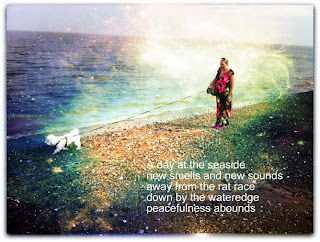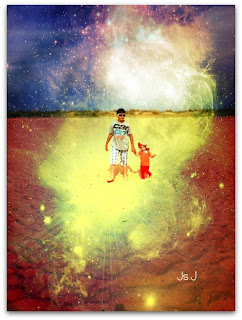Jsjcreations.com
Sharing the wonders of photographic manipulation
Photo manipulation is the application of image editing techniques to photographs in order to create an illusion or deception (in contrast to mere enhancement or correction), through analog or digital means.
 A few examples of photo manipulation worked on some photographs taken whilst enjoying a glorious day on the beach with my family. I love the way the effects I have used lend a different perspective to the original photograph taken and emphasize the focal points I want to share, in the images. I also love to express my creativity by experimenting and producing images that have been transformed in such a way that the original vision is somewhat metamorphosed into a completely different and almost abstract visionary experience.
A few examples of photo manipulation worked on some photographs taken whilst enjoying a glorious day on the beach with my family. I love the way the effects I have used lend a different perspective to the original photograph taken and emphasize the focal points I want to share, in the images. I also love to express my creativity by experimenting and producing images that have been transformed in such a way that the original vision is somewhat metamorphosed into a completely different and almost abstract visionary experience.
 Using photographic elements on standard photographs has enabled me to produce some powerful imagery and has gained me much positivity and encouragement to continue to improve and produce the very best I can with my artwork. No image is one dimensional and with the aid of photo manipulation tools the original image can be transformed into a wonderfully creative collaboration between photography and graphic design.
Using photographic elements on standard photographs has enabled me to produce some powerful imagery and has gained me much positivity and encouragement to continue to improve and produce the very best I can with my artwork. No image is one dimensional and with the aid of photo manipulation tools the original image can be transformed into a wonderfully creative collaboration between photography and graphic design.
Sharing the wonders of photographic manipulation
Photo manipulation is the application of image editing techniques to photographs in order to create an illusion or deception (in contrast to mere enhancement or correction), through analog or digital means.
I believe strongly that pictures or photographs are far more powerful when telling a story to the person viewing them. For that reason, when taking photographs, I rarely go for the typically posed positions and subjects, finding them contrived and visually manipulative and restricting.
"A day at the seaside
new smells and new sounds
away from the rat-race
down by the waters` edge.....peacefulness abounds"
 A few examples of photo manipulation worked on some photographs taken whilst enjoying a glorious day on the beach with my family. I love the way the effects I have used lend a different perspective to the original photograph taken and emphasize the focal points I want to share, in the images. I also love to express my creativity by experimenting and producing images that have been transformed in such a way that the original vision is somewhat metamorphosed into a completely different and almost abstract visionary experience.
A few examples of photo manipulation worked on some photographs taken whilst enjoying a glorious day on the beach with my family. I love the way the effects I have used lend a different perspective to the original photograph taken and emphasize the focal points I want to share, in the images. I also love to express my creativity by experimenting and producing images that have been transformed in such a way that the original vision is somewhat metamorphosed into a completely different and almost abstract visionary experience. Using photographic elements on standard photographs has enabled me to produce some powerful imagery and has gained me much positivity and encouragement to continue to improve and produce the very best I can with my artwork. No image is one dimensional and with the aid of photo manipulation tools the original image can be transformed into a wonderfully creative collaboration between photography and graphic design.
Using photographic elements on standard photographs has enabled me to produce some powerful imagery and has gained me much positivity and encouragement to continue to improve and produce the very best I can with my artwork. No image is one dimensional and with the aid of photo manipulation tools the original image can be transformed into a wonderfully creative collaboration between photography and graphic design.
*In digital editing, photographs are usually taken with a digital camera and input directly into a computer. Transparencies, negatives or printed photographs may also be digitized using a scanner, or images may be obtained from stock photography databases. With the advent of computers, graphics tablets, and digital cameras, the term image editing encompasses everything that can be done to a photo, whether in a darkroom or on a computer. Photo manipulation is often much more explicit than subtle alterations to color balance or contrast and may involve overlaying a head onto a different body or changing a sign's text, for example. Image editing software can be used to apply effects and warp an image until the desired result is achieved. The resulting image may have little or no resemblance to the photo (or photos in the case of compositing) from which it originated. Today, photo manipulation is widely accepted as an art-form.
There are several subtypes of digital image-retouching:
- Technical retouching
Manipulation for photo restoration or enhancement (adjusting colors / contrast / white balance (i.e. gradational retouching), sharpness, removing elements or visible flaws on skin or materials, ...)
- Creative retouching
Used as an art form or for commercial use to create more sleek and interesting creative images for advertisements. Creative retouching could be manipulation for fashion, beauty or advertising photography such as pack-shots (which could also be considered inherently technical retouching in regards to package dimensions and wrap-around factors) One of the most prominent disciplines in creative retouching is image-compositing. Here, the digital artist uses multiple photos to create a single composited image. Today, 3D elements are used more and more to add extra elements or even locations and backgrounds. This kind of image composition is widely used when conventional photography would be technically too difficult or impossible to shoot on location or in studio conditions.




No comments:
Post a Comment
Note: only a member of this blog may post a comment.